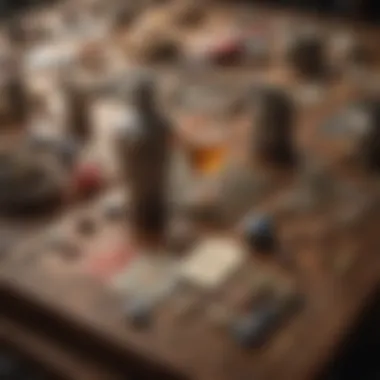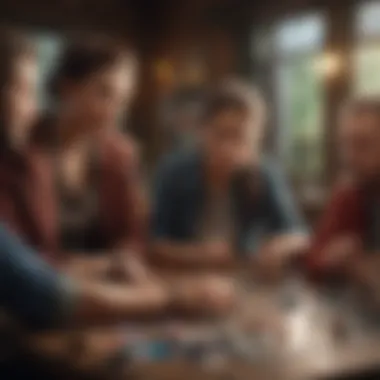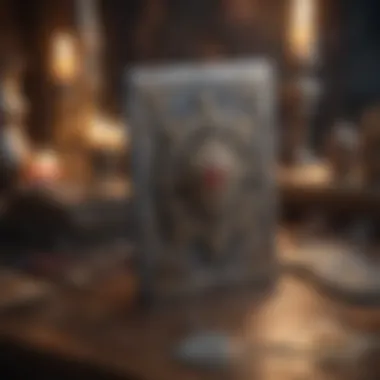The Deck of Many Things: Fate and Fortune in Gaming


Intro
The Deck of Many Things serves as a significant artifact in fantasy gaming culture. Emerging as one of the most iconic items in many role-playing games, it symbolizes chance, fate, and existential upheaval. Its influence stretches across multiple gaming platforms and resonates deeply with players and designers alike. Understanding its complexities opens a window into the nature of storytelling choices and their consequences. This exploration includes its origins, mechanics, implications for gameplay, and philosophical themes surrounding fate and consequence.
Overview of Cinema/TV shows/Games/Comic Books
The Deck of Many Things has made appearances across various media, most notably in tabletop role-playing games like Dungeons & Dragons. The concept provides a rich terrain for adaptation because of its inherent unpredictability and dramatic narrative possibilities. It has influenced not only games but also television shows and comic books, enthusiastic discussions about the outcomes and dilemmas shape engaging narratives. These adaptations prompt deeper exploration of fate in storytelling.
Recent adaptations have prompted renewed appriciation of its impact on storytelling mechanics. For example, the powerful storytelling in media like Critical Role, which frequently utilizes the deck, highlights character consequences in a tangible way, motivating viewers emotional involvement. It's not uncommon to see players drawing upon the artifact's chaotic nature to generate surprising plots, resulting in diplomatic dialogues and complex interactions.
- Latest Updates: Discussions in online forums such as reddit.com reflect current trends around The Deck of Many Things; players frequently analyze its mechanics and share anecdotes stemming from its unpredictability.
- Trends and Popularity: Increasing interest in the deck brings player-driven modifications resulting in unique homebrewed decks, merging your character’s destiny and gameplay splits opinions on their use.
- Releases: Many games are now introducing variants of the deck into their systems, often characterizing repercussions that actors face with every draw. These updates push gameplay from mere existences into meaningful narratives with stakes.
In-Depth Analysis
Gameplay and Mechanics
The Deck consists of cards, each carrying implications for game mechanics and storytelling. Unique effects range from powerful boons to disastrous curses. Each draw reshuffles the balance of likelihood within the game universe. This interplay engages players in decisive moments, elevating emotional stakes. Effects like fortune and doom catalyze stories, compelling players towards inevitable yet unpredictable outcomes.
Implications of Fate
The theme of fate becomes more evident when considering variations of the deck and its implementations across various games. It's fascinating how a single choice can morph a character's journey significantly. Players understand and anticipate consequences yet remain intrigued by their fateful pulls.
“The unpredictability of the Deck encapsulates a beautiful arrangement of possibilities, forcing players to decide and reconsider their resolves.”
Cultural Resonance
The decks' narrative potential has led to representation in comic books and dedicate episodes in animated series, depicting uncertain circumstances driven by fate's whims.
Behind the Scenes
Development Process for Games
Game developers have integrated varying styles and visual representations of the Deck within their systems, yielding a IT culminative effect on gameplay. Engineers pave innovative funtionality feedback loops, solidifying the inherent role of chance amongst characters in numerous ways. Engaging player perspectives enhance narrative depth, continuing exploration for optimal storytelling outcomes.
In summary, the Deck offers opportunities bound by its design, emerging from traditional mechanics and rejecting pigeon-holed maneuvers prompting attachment and complexity, be it tabletop games or visual adaptations in screen and print.
Closing Thoughts
The Deck of Many Things encourages players to reflect upon the consequences of their choices in an unpredictable manner. Ultimately, its significance transcends mere gameplay; it shapes narrative experiences across a variety of gaming platforms, providing thought-provoking experiences.
Intro to the Deck of Many Things
The Deck of Many Things remains an intriguing and complex artifact within fantasy gaming. Its worth extends beyond mere game mechanics; it symbolizes aspects of fate, chance, and consequence that resonate with players. Understanding the intricacies of the Deck enhances gameplay and addresses a rich vein of narrative potential determinable by each draw of a card.
Historical Context
The origins of the Deck of Many Things can be traced back to early tabletop role-playing games. Introduced in the Dungeons & Dragons framework, it drew inspiration from various mythological and narrative traditions. It exists as both boon and bane influencing the direction of adventures and character development entirely randomly. Early players were enthralled by the unpredictability it introduced to campaigns, enhancing an already dynamic gaming experience. They engaged deeply with themes of resilience and adaptability as their characters navigated rewards and penalties that ensued from the draws. Over time, the card deck has become distinguished, seeming to reflect a bridging of player agency and narrative chaos, thus embodying historical influences from folklore to literary works.
Definitions and Mechanics


In its fundamental definition, the Deck of Many Things is a collection of cards containing distinct and varied effects. Each card has unique properties—some induce momentous changes while others can lead to catastrophe. Players encounter the object during gameplay through a specific ritual—drawing cards from the deck. The acts of drawing and resolving these cards create a narrative pulse characterized by unexpected turns.
To understand its mechanics better, it can be beneficial to categorize these cards:
- Beneficial Effects: Cards that grant powerful boons, such as increased abilities or magical enhancements.
- Detrimental Effects: Cards causing harm or hardship, such as loss of power or cursing a character.
- Neutral Effects: Draws that may not be immediately impactful but offer role-playing opportunities or guide future decisions.
The blend of these elements fosters anticipation, provoking players to evaluate their circumstances critically. The unpredictable likelihood of success instills excitement, crafting moments of triumph and trials alike.
Origins and Development
The Deck of Many Things holds a significant place in the tapestry of fantasy gaming, particularly within tabletop role-playing games. Its origins and development reveal much about the cultural foundations of gaming and how its mechanics have influenced stories and player experiences. Exploring this history not only provides context but also showcases aspects of chance and creativity that have persisted through different gaming platforms. This section offers insight into how the Deck evolved and its formative role in enhancing the engagement of players.
Early Appearances in Tabletop Gaming
The inception of the Deck of Many Things can be traced back to early Dungeons & Dragons campaigns. First introduced in the 1976 edition, the card set represented a radical departure from linear storytelling by introducing chaotic elements that could dramatically shape gameplay outcomes. The cards present unpredictable consequences for characters, encouraging risks that would enhance the game’s thrill factor.
Players reacted with both excitement and trepidation as they drew cards that could grant astounding benefits or tragic losses. This element became an instant magnet for players seeking dynamic interactions and immersive narratives. Since its early introduction, the Deck of Many Things has become a staple within the Dungeons & Dragons universe and has inspired various adaptations in other tabletop games. Its chaotic nature invites innovation and unique storytelling.
The mystical allure of the cards is an essential part of the game, prompting investigators for strategies that would mitigate risk while maximizing potential rewards. Such strategic elements encourage interaction among player characters in multidimensional ways.
Evolution Through Editions
As tabletop gaming evolved, so did the Deck of Many Things. Major editions of Dungeons & Dragons have revisited the card dynamics, modifying rules and graphics. New versions have reiterated the original chaos while enhancing player experiences influenced by player feedback. In the second edition, for example, specific effects of cards were adjusted to remain relevant while still retaining unpredictability. Later editions provided clarifications that targeted balance, reducing the ambiguity that earlier editions produced.
Further changes continued in subsequent versions, adapting not just the rules but the art itself, effectively making the deck visually engaging. It affirmed the Deck of Many Things as more than just a gaming element; it turned it into an experience, entwining fate and fortune with aesthetic enjoyment.
Ultimately, these changes reflect a broader trend in tabletop games: the constant chase for balance between creativity and gameplay integrity. Each edition re-envisioned the relationship between player choice and outcome, paying homage to early influences while inviting further innovation. The richness of this evolving artifact reflects the gaming community's desire for daring adventures complemented by an engaging narrative unfolding one card at a time.
Gameplay Mechanics and Dynamics
Understanding the Gameplay Mechanics and Dynamics of the Deck of Many Things is crucial for both players and game masters. The mechanics dictate not only how the game interacts with its participants but also drive the narrative forward. They create an intricate balance between chance, strategic foresight, and player agency.
Drawing cards from the Deck initiates a randomness that excites and terrifies players. Each card drawn can change a campaign dramatically, transforming the narrative trajectory. Because of its unpredictable nature, it serves as a catalyst for intense engagement with the storyline. However, with power comes responsibility. Game masters must carefully consider how much influence and consequences the Deck has on the players.
Drawing Cards: A Ritual of Chance
Drawing cards is at the heart of the Deck of Many Things. It symbolizes the weighing of fate against choice. The act is more than a random selection; it serves as a ritual within the game. Players often approach this decision with a mix of eagerness and apprehension, understanding that a single card could led to a great boon or a calamitous effect. This transformative aspect of gameplay highlights a compelling interaction between players and mechanics.
The anticipation builds as players discuss potential outcomes. How many cards will they draw? Are they prepared for the risks involved? Game masters often enjoy watching these conversations unfold, fostering tension and excitement around the table.
The consequences of this act extend far beyond the initial moments of gameplay. Each card literally acts as a narrative shard, refracting the story in unforeseen directions. As luck plays in their favor or against it, the entire campaign shifts dramatically.
Effects and Consequences
The effects and consequences evoked by the Cards in the Deck are some of the most fascinating aspects of its gameplay dynamics. Each card drawn delivers unique and often complex outcomes. From riches and boons to curses and devastating events, these effects shape player decisions and the overarching campaign directly.
The enduring enjoyment derived from the Deck lies in how each card encourages essential storytelling. Here are some typical results from the Deck:
- Gain a magical item that could redefine character paths
- Experience catastrophic defeat, impacting players both emotionally and strategically
- Encounter unexpected allies or powerful enemies based on mix-ups of fate


Gamemasters need a firm understanding of their players' dynamics. A straightforward boon could transform into an unchecked power disparity. Conversely, a heavy consequence might render the game unplayable. Controlling the frequency of drawing from the Deck or providing wise counsel may help manage narrative flow better, balancing excitement with sustainability.
Strategic Usage in Campaigns
The strategic usage in campaigns of the Deck highlights a critical layer of gameplay dynamics. Where and when players choose to use the Deck greatly affects their overall gaming experience. A savvy player recognizes the weight of their decision; timing can turn fortunes. Integrating the Deck at pivotal moments will foster unexpected drama or surprise resolution. Here are a few roles for integrating the Deck:
- Introducing the Deck as a Plot Device: Use the Deck to push the narrative forward at climactic points in the campaign.
- Building Player Investment: Encourage players by linking the cards to their personal stories, creating emotional stakes connected to the outcomes.
- Designing Campaign Arcs Around Randomness: Plan sessions where different options based on card outcomes change story arcs dramatically.
By mapping out these strategies, game masters conserve the integrity of player agency while guiding unpredictable elements that keep players engaged. Ultimately, the Deck of Many Things weaves a complicated tapestry of fate, luck, and active storytelling within the framework of fantasy gaming.
Philosophical Themes
Exploring the philosophical themes surrounding the Deck of Many Things provides crucial insights into its role within fantasy gaming. This section addresses how the themes of fate, free will, and luck are intricately woven into gameplay. Understanding these concepts not only improves player engagement but also enriches narrative experiences, deepening their emotional impacts. As players interact with the deck, they confront questions about their choices, fate, and the inherent chaos of the game.
Fate vs.
Free Will
The dichotomy of fate and free will can be seen vividly in how the Deck of Many Things operates. The deck embodies randomness, suggesting that outcomes can hinge on chance alone. This randomness can create a jovial but tense atmosphere. When players draw a card, they often face profound consequences, leading to discussions about the nature of their characters’ paths.
On one hand, using the deck implies surrendering to fate, accepting whatever powers draw out their circumstances. Alternatively, players can interpret these draws as a balancing act of invoking their agency. Their character decisions can off-set or amplify the deck's outcomes, resulting in nuanced storytelling that subtly morphs from script to improvisation. This conflict can encourage players to examine their own belief systems besides fostering critical dialogue during game sessions.
The Role of Luck in Storytelling
Luck plays an integral role in any storytelling, especially in the realm of fantasy games. The Deck of Many Things is a quintessential illustration of this concept. It shows how unexpected events can propel storylines in uncharted territories. Gamemasters benefit by incorporating luck into narratives, leading to unique character arcs and surprises.
The Deck of Many Things encourages a fresh perspective on narratives. As events unfold, players might experience phenomenal successes or grappling defeats all due to sheer luck. For example, a powerful card could allocate a boon while the next instantly brings downfall through intrinsic threats. The balance creates an environment charged with unpredictability and excitement.
Luck influences characters and stories, cultivating conflict and driving their endeavors. A well-timed card draw can ignite a series of adventures or steer a campaign into unfamiliar and thrilling territories, aligning the mechanics of luck with core storytelling paradigms. This intersection offers opportunities for plots to shift dramatically based on the cards drawn, enhancing every exploration into fate, free will, and story development.
Cultural Impact
The Deck of Many Things has carved a significant niche in the landscape of fantasy gaming. Its cultural resonance is evident not only in tabletop sessions but also in various multimedia interpretations. The artifact's role transcends mere mechanics; it embodies the whims of fate, risk, and unpredictability. Such themes echo through different layers of storytelling, influencing how narratives are constructed in video games, literature, and other forms of media.
Representation in Video Games
Video games have often taken cues from tabletop gaming, and the Deck of Many Things has surfaced in several digital titles. For instance, Baldur’s Gate II: Shadows of Amn dives into this concept, allowing players access to an experience that mimics its chaotic beauty. Players pulling cards triggers a wide array of potential outcomes, from bountiful rewards to dire penalties. This unpredictability heightens engagement, compelling players to embrace chance in their adventures.
Additionally, other modern role-playing games like Slay the Spire have integrated card-drawing mechanics, showcasing how a central theme from the Deck influences structure. The impact extends beyond direct references; it affects how game designers conceptualize challenges and rewards. By embedding the essence of the Deck into gameplay, various titles foster excitement and encourage creative problem-solving.
Influence on Narrative Structures
The influence of the Deck of Many Things on narrative frameworks is profound. In stories where choice and consequence play pivotal roles, the Deck serves as a representation of life’s unpredictability. It often inspires designers to craft nonlinear stories where player choices yield significantly diverse narratives.
Moreover, as writers and developers draw from the notion of fate embedded in the Deck, their narratives become rich with thematic depth. By employing high-stakes dilemmas, content creators can explore complex character arcs and moral ambiguity. Narratives shaped by the same chance principles yield enduring storytelling experiences, as viewers or players ponder the impact of their choices in the context of overarching fate versus agency.
This is a prime example of how gaming artefacts, like the Deck of Many Things, can transcend their primary purpose and inform broader narratives.
As players pass through the baroque corridors of fate's shadow, they experience the intermingling of storytelling elements that can confer personal significance. The phrase “chance governs all” resonates in various media, making the Deck relevan across cultural landscapes.


Comparative Analysis
Understanding the comparative analysis of the Deck of Many Things within the context of fantasy gaming reveals its unique characteristics while also shedding light on similar artifacts in other games. This section aims to illustrate how these companions in gameplay affect narrative structures and player experience. Such an examination is crucial, as it can provide insights about thematic resonances across multiple gaming platforms.
Similar Artifacts in Other Games
Artifacts that influence gameplay dynamics can be found spread across various game systems, leveraging elements of luck, strategy, and player agency. Examples include:
- Fortune Cards in games like Betrayal at House on the Hill. These cards introduce chance elements that can add sudden twists in the plot.
- Illuminati features various cards, which alter outcomes and introduce unpredictable changes, creating chaotic, thrilling gameplay.
- In Magic: The Gathering, cards with random effects can overwhelmingly affect the flow and outcome of the game, similar to the unpredictability found within the Deck.
These artifacts enhance participation by making unpredictable authors of fate while presenting moments that provide substantial surprises to players.
Distinct Features of the Deck
The Deck of Many Things is distinguished by its unique mechanics and deep contextual significance. Unlike many artifacts, it influences story outcomes not through incremental advantage, but through sweeping decisions that can alter the trajectory of an entire campaign. Here are prominent features that set it apart:
- Random Draw Mechanism: Each time a card is drawn, a potentially game-altering effect may arise. This randomness impacts player decision-making and tension levels.
- Life-altering Outcomes: Some cards can bestow significant boons such as permanent stat boosts or magic items, while other cards might also pose major threats like unexpected death or imprisonment.
- Cultural Footprint: Its integration into gaming history showcases larger themes of fate and high stakes, thereby enriching the gaming dialogue.
The Deck of Many Things encapsulates philosophical debates about chance and consequence, as it plunges players into a realm wherein every choice could lead toward triumph or catastrophe.
Case Studies
The study of notable instances involving the Deck of Many Things provides critical insights into its impact on gameplay and storytelling. Examining specific case studies allows us to appreciate how this artifact shapes player dynamics and the narrative flow. Each campaign acts as a distinct experiment, showcasing the diverse interpretations and outcomes tied to this unpredictable card game element.
Notable Campaigns Featuring the Deck
Several campaigns have integrated the Deck of Many Things, each unfolding uniquely based on player choices and game master interpretations. One notable campaign is Critical Role, where several characters drew from the Deck's cards, resulting in significant shifts in their destinies. This inclusion revealed players' reactions to both boon and bane, thus enhancing emotional investment in the narrative.
Another mention would be the Baldur's Gate series, especially its expansions. Characters could interact with the Deck, allowing the unpredictable effects to manifest within their adventures. This forced players to think critically about risk and reward, serving both excitement and suspense.
These campaigns demonstrate that the usage of the Deck can amplify tension, add layers to character development, and lead to unexpected plot twists. Highlighting character relationships and rivalries, the behavior of each player when faced with potential rewards or repercussions becomes a central theme.
Best Practices for Game Masters
When incorporating the Deck of Many Things into gameplay, game masters (GMs) must navigate the complexities that come with its unpredictable nature. Its powerful effects can lead to dramatic shifts in a campaign's course. Therefore, understanding best practices ensures that its usage enriches the game rather than disrupts it.
Integrating the Deck into Gameplay
Integrating the Deck of Many Things requires careful planning. GMs should consider the overarching context of their campaigns. Is the campaign light-hearted or serious? The tone of the story can influence how the cards are received. Here are some specific considerations:
- Introduce Gradually: Rather than presenting the deck at the very beginning, consider building suspense. Introduce elements of mystery about this artifact, cultivating player interest.
- Provide Clear Rules: Although chaos reigns when drawing from the deck, outlining the basic rules about its use ensures players know what to expect. Clarity decreases player anxiety while inviting excitement.
- Narrative Context: Tie the deck’s introduction into the campaign’s narrative. Whether as a reward for a quest or a cursed relic, its positioning adds layers to your story. Players appreciate meaningful interactions more than arbitrary choices.
- Optional Draws: Consider allowing players the choice to draw cards. When they have agency, the thrilling aspect of danger becomes heightened yet conscious. Appropriately managing player risk maintains engagement.
Finale
Summary of Insights
The Deck of Many Things is not merely a gaming tool; it stands as a complex emblem of unpredictability within the narratives of fantasy gaming. This article outlined its rich history and the unique mechanical interactions it fosters within campaigns. Through detailed examination, the various impacts of this deck were highlighted: it alters character fates, challenges player strategies and injects an intriguing layer of risk into storytelling. The philosophical questions it raises concerning fate versus free will resonate throughout many role-playing sessions, inviting deeper engagement with players’ backgrounds and decisions.
Furthermore, the cultural implications of the Deck of Many Things extend beyond the tabletop. Its representation in video games and narratives has served as a direct influence on game design and narrative frameworks. This evolution reflects an ongoing conversation in the gaming community about chance, equilibrium, and the delicate balance between narrative agency and randomness.
Future Directions in Gaming
Anticipating future directions within this domain, potential avenues involve a deeper integration of variant deck systems within game mechanics. As game design shifts to embrace more nuanced role-playing experiences, developers may explore multiple variants of the Deck of Many Things, giving unique flavor in each campaign. This could foster differentiated play styles, altering not just the card effects but also the entire arc of player development.
Also, with the rise of digital platforms, the transformative adaptation of the Deck into mobile and virtual reality spaces seems likely. Enhanced accessibility through technology presents opportunities for real-time influences, integrating more dynamic interactions with fate and fortune. These shifts may also cultivate an expansion of narrative complexity suitable for more intricate character development pathways.
Finally, as gaming evolves towards greater inclusivity, adapting these traditional mechanics with culturally diverse perspectives could enrich the narratives surrounding chance and fate. Exploring decks that transcend familiar tropes could promote broader engagement across varied guilds of players, ultimately pushing the boundaries of storytelling in gaming.



